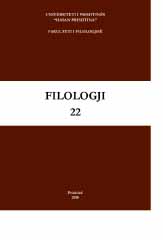SIMBOLI DHE RIVALËT E TIJ
THE SYMBOL AND ITS RIVALS
Author(s): Basri ÇapriqiSubject(s): Language and Literature Studies, Semiotics / Semiology, Applied Linguistics
Published by: Univeristeti i Prishtinës, Fakulteti i Filologjisë
Summary/Abstract: Derived from the Greek symbolon, the word ‘symbol’ is used today in most of the other languages, similarly or approximately, with slight differences in spelling and pronunciation: symbol in English, symbole in French, Symbol in German, simboll in Russian, simbol in Albanian, etc. Since times when the symbol was confused with allegory in Greek culture to this day when the symbol is related to interpretative polysemy, indeterminacy, and infinitude, this concept has been treated variously in different ages. The most significant studies on the complexity of the symbol are related to various semiotic categories, to the theory of literature, to aesthetics, to the philosophy of language, to psychoanalysis, to interpretation, etc. Most often these studies have pitted symbol vis-a-vis its rival terms or, else, have distinguished between this and similar concepts with which it has been confused in various stylistic formations. The true nature of the symbol cannot be rightly understood without clarifying its close relationship to the following: code, allegory, sign, myth, semantic vagueness, numinosity, encyclopedia, codex and the dictionary of symbols, then further to icon, referentiality, analogy, to the hidden and the forbidden, archetypes, the statement, and proposition. Some of these terms have now and then been considered synonymous with the symbol, thus giving rise to a confusion that has lasted to the present day.
Journal: FILOLOGJI
- Issue Year: 2018
- Issue No: 22
- Page Range: 9-32
- Page Count: 24
- Language: Albanian

